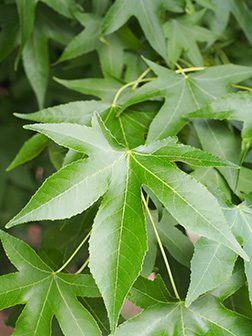Liquidambar styraciflua L.
Mature Size: 60 to 90 feet in height, 2 to 3 feet in diameter
The Sweetgum can be found in rich river bottoms, swamp edges, and drier uplands, providing a beautiful mix of yellow, orange, purple, and red fall colors often on the same tree. It gives out a beautiful array of fall colors from red to pink to orange and yellow, and of course, the tree does drop spiked gumballs. Small songbirds, chipmunks, and squirrels feast upon the seeds of the gum balls, and the twigs are browsed by mice and rabbits. It is a host plant for more than 30 species of butterflies and moths.
Fun Facts: Native Americans used the resin to make dental hygiene products, and early pioneers used it to make chewing gum. Did you know it takes 15-20 years for the resin to bear fruit?


For more information:
http://dendro.cnre.vt.edu/dendrology/syllabus/factsheet.cfm?ID=53
Photo credits to: Virginia Tech College of Natural Resources and Environment: https://dendro.cnre.vt.edu/dendrology/factsheets.cfm

